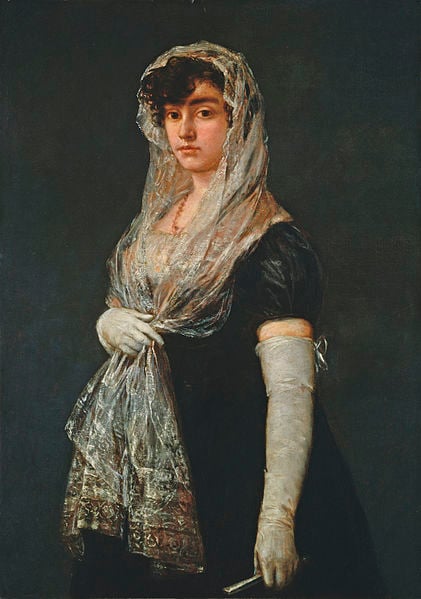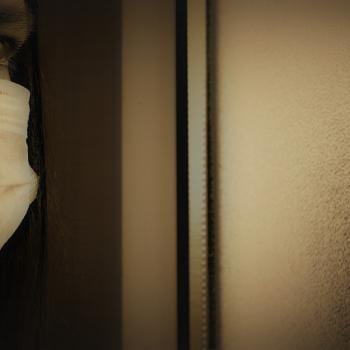Long ago in my undergraduate days, I went through a phase of preferring the old Tridentine mass. I would like to say that this was part of my search for more complete religious devotion, but the depressing reality is that I was looking for new ways to signal my superiority, since I was an awkward academic on a campus that prized winsome sprightliness in women, and I hadn’t yet discovered Christian feminism, or the easeful truth that magnanimity is finer than competition.
So it was never a real devotion, though I do love beautiful churches, and organ music, and some chant. I wore a long lacy black mantilla, and while I pretended this was piety, it was actually vanity. I hoped I looked mysterious and sexy. Since the wretched thing kept slipping out of my hair no matter how many pins I used, probably I looked more like a drunken pilgrim with a tablecloth on her head. It never made me feel more prayerful, and when I finally admitted to myself, reluctantly, that I’d been shamming religion, I was glad to give up the unequal struggle with gravity and lace.
Lacy stuff on my head isn’t really my aesthetic anyway: I only like it as trim on a pirate costume.
Since then, I have encountered a number of rationales for veiling that make me glad I gave it up, as the reasons given are often either stupid or sexist or both. And the communities in which veiling is popular seem to emphasize false, gendered ideas of virtue that are contrary to the Christian vision (women are nurturers while men are fighters, etc etc) – as well as to promote suspicion of anyone “other.”
But, every time I decided to make up my mind that veiling is an outmoded element of a patriarchal appropriation of religion, or an anachronistic continuation of a tradition that has no relevance in the social structures of today, I met another intelligent and sincerely religious woman who chose to veil. This fascinated me, so I decided to find out why Catholic women in the western world, from a variety of backgrounds, choose to veil or not veil.
For the most part, I found that women who shared my faith also shared my views on veiling. Jenn said: “it’s never been something I wanted to do. I did once when I attended an SSPX wedding and it took all the power in my hands to not fidget with the blasted thing. It doesn’t make sense to me as it’s not common anymore, so I think I’d feel like I stood out.” Heather stated that she was uncomfortable with both “the constant fidgeting with it,” and because she “came to associate it with some people who are somewhat pharisaical.” Mary Beth stated that she dislikes them because she finds them dividing: “Since we don’t belong to a church that demands women cover their hair (like in other religions) in my opinion women who do wear chapel veils just give off a sense of a ‘holier than thou’ attitude that’s off putting.
Amy veiled for a while. “I bought into the idea that it was more traditional, and that it helped keep me focused and prayerful and was a witness to others,” she said. “But it quickly became a burden and I was constantly self-conscious when I was the only one veiling at a certain mass.” So eventually she stopped veiling. If I ever went back to covering, it would be with something other than a gaudy lace veil which doesn’t go with anything I typically wear anyway,” she said. April was very forthright on the topic: “No, I did not, do not, will not. Perhaps in my younger years of needing to gain the approval of those I believed were holier than myself, I may have – but that would have been for the wrong reasons. My older self does not veil because it doesn’t fall in line with my theology, my practice and my particular relationship with God and Church. On the practical side, in my area, anyone who veils is usually judged as a traditionalist who doesn’t understand the church of today and as someone who works for the church, I would not like that to be the way anyone views me.”
Kate’s reasons for choosing not to veil were similar to those above mentioned, with an added observation: “the only explanation I’ve ever found for veiling that really makes sense to me is that hair is really beautiful, and that the Mass is supposed to be about focusing on God, not drawing attention to ourselves; therefore, Mass should not be the place where we show off our personal beauty. I have never seen anyone use this as a reason for not wearing makeup, brushing one’s hair, or dressing up for Mass, however… Now, I am extraordinarily vain about my hair. I love my hair. When I wear it down, I think it’s gorgeous. I have never figured out how a translucent veil would hide that fact from anyone, least of all me. (Side note: If veiling is about covering our glory, why are chapel veils translucent? How does that cover anything? Haven’t you ever seen racy in photos of Oscar night, where someone is inevitably wearing something translucent on the red carpet, and their thinly veiled nipples just scream, “Look at me!”? That’s what chapel veils do for glorious, sexy hair, in my opinion. They’re the ecclesiastical equivalent of Gypsy Rose Lee taking off just one glove.)”
Interestingly, the arguments that Genevieve had heard for veiling were quite different: “I cringe when people refer to women in veils being more beautiful…the point of Mass is not to flaunt yourself, to seek to enhance your personal attractiveness. Often proponents of veiling compare the enhanced beauty of veiling to a sculpture or altar vestments, (but) women are not objects and their beauty is an integral part of their souls, not as a matter of decoration. Consider how we do not discuss whether men could be more beautiful for the Mass like beautiful altar linens. With this mindset, one might chose to wear a elaborate make-up or a ball gown to mass or suck in one’s gut the entire time because it enhances the beauty. Or one might not be beautiful enough to attend. I know that is the ridiculous, but where do you draw the line when being pretty or decorating the Supper of the Lamb is on the line? Jesus would never show up less than properly – oh, wait, his attire was whipping stripes, nevermind.”
Are veils supposed to make us beautiful, or not? Here, as in debates about modesty, we women are left uncertain as to whether our prettiness is commanded or forbidden. It is understandable why so many of us are uncomfortable with the practice, since we are tired of being spoken of as objects, even nice objects, like gifts or decor.
But some women like veiling on occasion. Mary enjoys it aesthetically, in the right setting: “I do when I go down to the spooky traditional church, because I like accessories and I like feeling like I’m in the proper costume for an event. But I don’t care what anybody else does.”
Daniella also enjoys the variety of liturgical expressions: “I enjoy veiling,” she said. “However, I don’t think it’s holier or more correct, just a beautiful option. However, one of the things I love about being Catholic is I can decide last minute that since I’m out, I’m going to go ahead and go to the Saturday Evening Vigil Mass in my jeans. In my heart of hearts I truly don’t think God cares if I’m veiled or in my jeans,just that I’m there.”
And for some women, wearing a veil is preferred. Brigid says she likes them “because they are a brilliant use for my scarf collection (I don’t wear lace ones, just scarves over my hair); I don’t have to do my hair or make up because they hide my hair and face in mass, they’re nice and warm in winter, and they help me be less distracted, because I wear mine like racehorse blinders.” In this case, wearing a veil becomes a matter of the subject’s internal disposition, how she looks at the liturgy, not how others are looking at her. I appreciate that.
For Clara, wearing a veil is a very special part of her religious devotion: “it’s a physical reminder literally sitting on your head that you are in a sacred place, in the presence of Christ. There’s a beauty in the moment right before walking into a church where I pause and veil myself–I kind of think of the prayers that priests say before donning holy vestments, and I try to infuse some of that deliberate intention into the act for myself as a preparation for entering a holy place….I also really love the symbolism of the woman as bride of Christ–while we all make up the Church, women embody her more specifically. If the Mass is the wedding feast of Revelations, and I symbolize the Bride, wearing a veil (specifically a veil for me, though obviously any head covering) really drives that home for me.” Clara said she was “a little surprised and disappointed by the hostility…towards people who wear head coverings, especially veils. I can assure you that I am personally not giving a crap about anyone else because I’m desperately trying to pay attention and not get distracted by literally everything. And also because I’m a sinner and I should see to myself before trying to judge anyone else. I don’t think wearing a veil makes me holier or better than anyone, it’s just a devotion that I was drawn to on a completely personal level.”
This was a valuable reminder to me that those of us who have felt frustrated by the judgmental attitudes of others should be careful to avoid mirroring those attitudes, when we meet those who have opted for different religious devotions. While there certainly are bad, outmoded reasons given by some for veiling, reasons that contradict one another and objectify women,that does not mean that a woman who opts to veil does so for these reasons. The church offers us many different traditions and devotions, within a variety of cultural frameworks. The meaning of a symbol does have its roots in collective intention, but collective intention can differ from one community to the next, and a symbol that may be negative in some contexts can be positive in others.
I still have no desire to veil myself, though I may occasionally sport a fedora, but I do intend in the future to be more respectful to women who find veiling enhances their religious experience, and to be wary about making assumptions about their beliefs or motives. Our religious experience is enriched and deepened when we learn from, instead of judging, one another.
image credit: https://commons.wikimedia.org/wiki/File:Goya_-_Young_Lady_Wearing_a_Mantilla_and_Basquina.jpg. Public domain in the US (PD-US)













